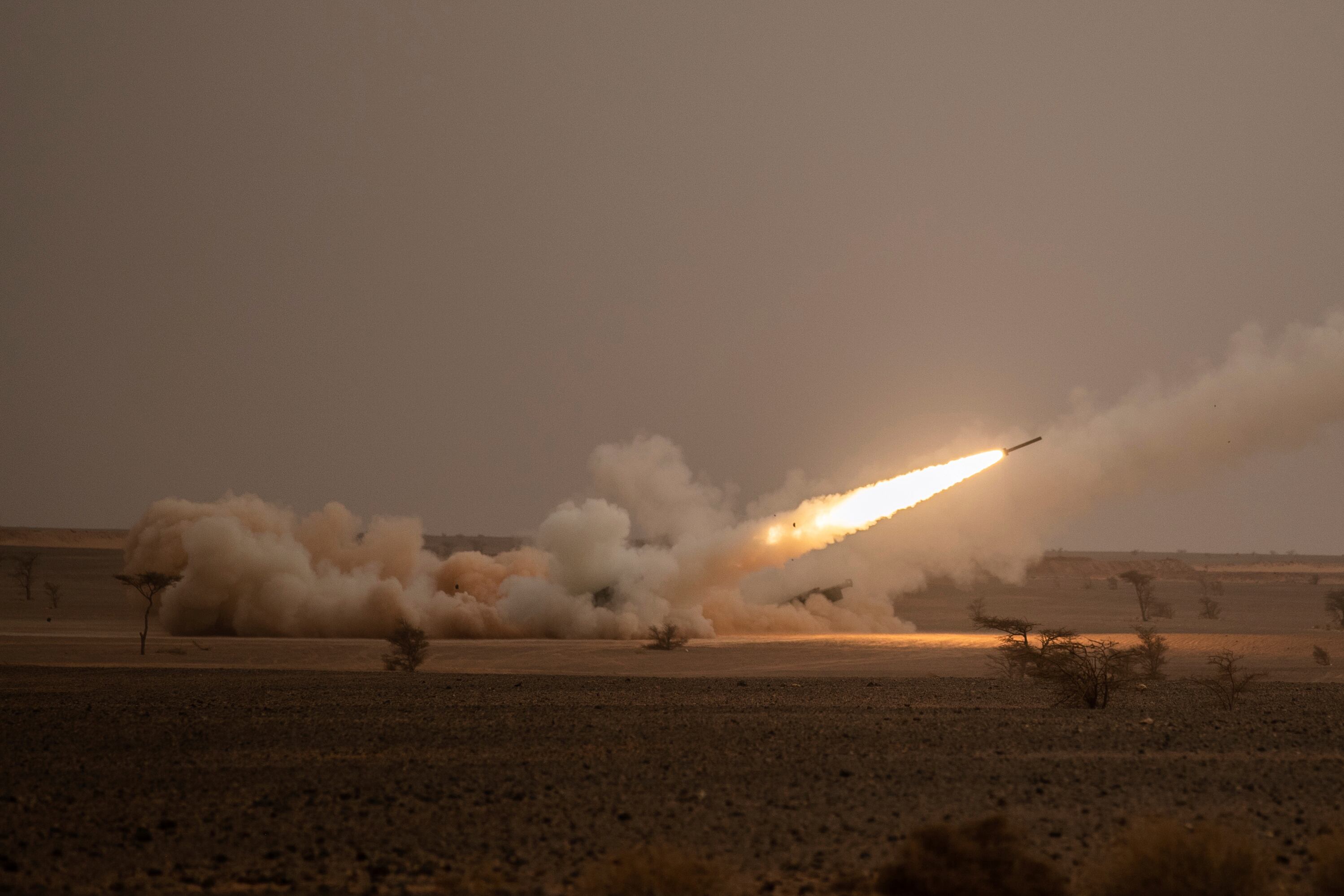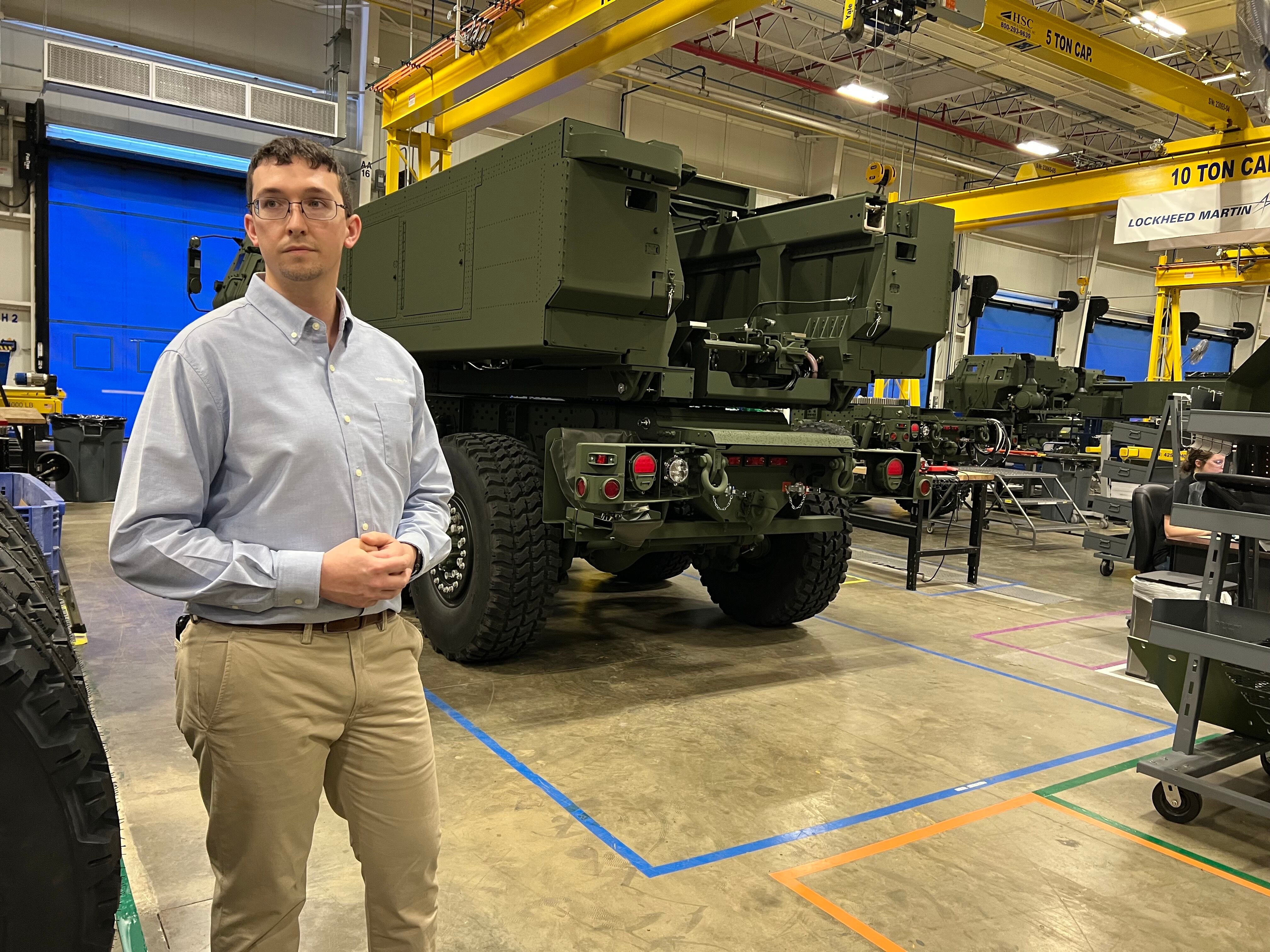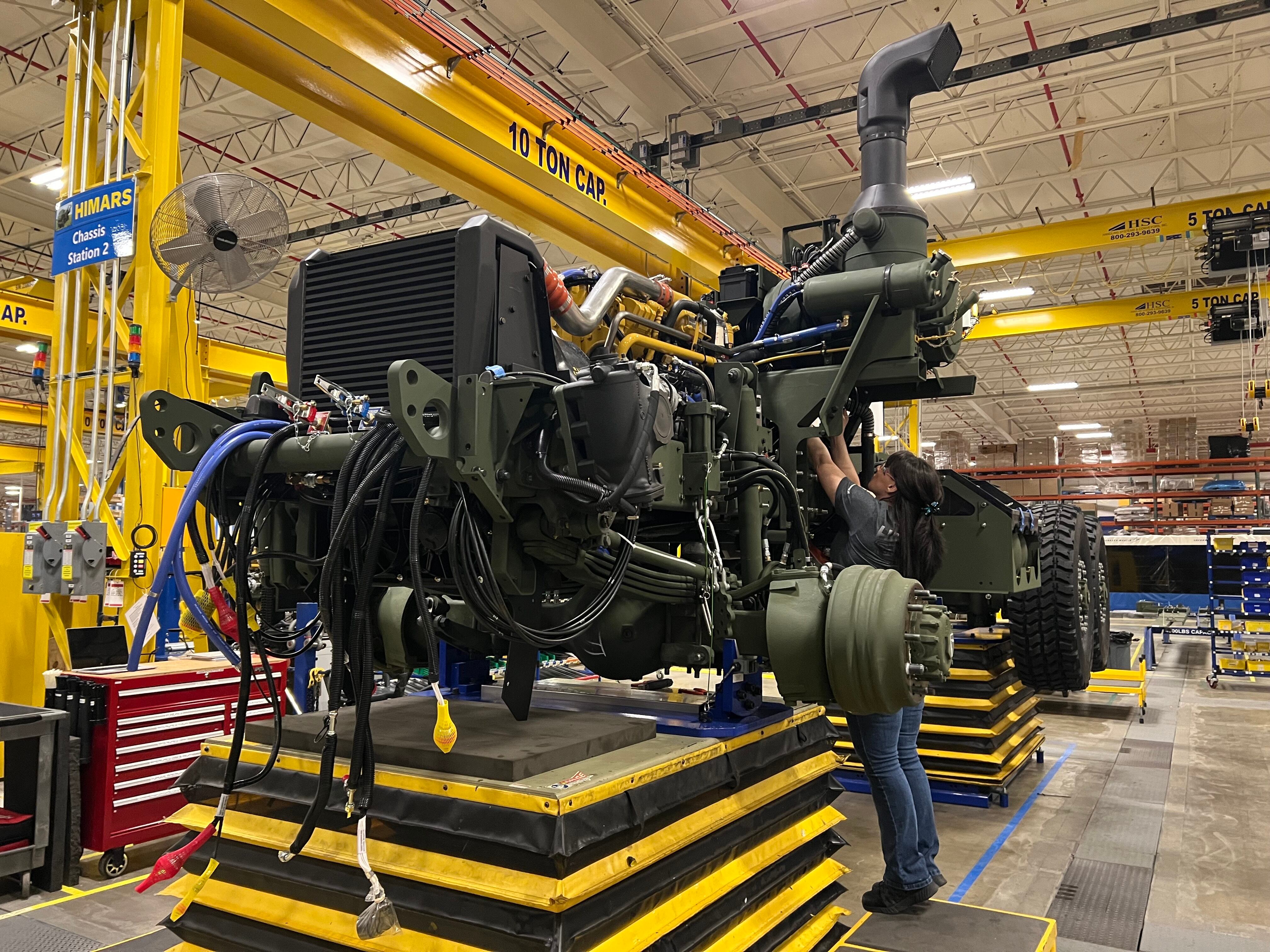CAMDEN, Ark. — In downtown Camden, in south-central Arkansas, a large number of storefronts sit dark and empty, offering little insight into what once thrived there. On one block, only a florist and an artisanal soap shop were open on a recent Monday.
“This building is not empty, it’s full of opportunity,” a sign on another block’s storefront read.
But 10 minutes away, the Highland Industrial Park was bustling and its parking lot full as some of the nation’s largest defense contractors — Lockheed Martin, Aerojet Rocketdyne and General Dynamics — manufactured solid-rocket motors, missiles, launchers and other weapons systems that proved critical to the U.S. military and are now front and center in Ukraine.
Camden has long depended on the defense industry. For example, since 1980 Lockheed Martin has locally built its M270 Multiple Launch Rocket System — a tracked rocket launcher that can carry a dozen rockets or missiles. A mural featuring the system covers the entire back of a building in downtown.
Now the Lockheed facility is manufacturing the High Mobility Artillery Rocket System as quickly as it can.
The HIMARS — which carriers fewer rockets and missiles than its predecessor, the M270, but is more nimble — is attracting worldwide attention for helping Ukraine fend off Russian invaders. And it has put Camden’s bustling defense industry in the spotlight.
Ukrainian President Volodymyr Zelenskyy said the launcher made a “huge difference” in liberating critical areas of the country under Russian occupation. Late last year he presented a medal from a HIMARS officer to U.S. President Joe Biden.
The Arkansas Chamber of Commerce has named HIMARS “the coolest thing made in Arkansas,” beating out more widely known products like Cheetos.
And Lockheed in recent months won nearly half a billion dollars in new contracts to build HIMARS and guided rockets for Ukraine. That’s a sizable number, considering Arkansas exported $1 billion of defense and aerospace goods in 2020.
Local officials are hopeful expansion at Lockheed and dozens of other defense contractors in Camden’s Highland Industrial Park, driven by the demand for weapons for Ukraine, will lead to growth in their region.
The state’s Chamber of Commerce anticipates Ouachita County, home to Camden, will see an influx of new employees — up to 1,000 total — at defense firms. In the meantime, state, local and industry officials are weighing how to best recruit and retain these employees.

Hot, cold, and hot again
The M270 has a long legacy in Camden. Building off that, Lockheed in the 1990s developed HIMARS as a lighter, more mobile rocket launcher. The U.S. military first fielded the new system in 2010, but didn’t stay in production long. The Army and Marine Corps wrapped up their orders in 2013, and the production line in Camden went cold in 2014.
But it wasn’t long before Lockheed needed it again. In 2015, the U.S. State Department approved the United Arab Emirates to buy 12 systems along with accompanying missiles in a $900 million deal. By 2017, HIMARS production was underway again.
Still, it was more complicated than simply restarting the production line, according to Becky Withrow, director of business development for the company’s tactical missiles portfolio, based in Grand Prairie, Texas. The previous HIMARS launchers were built using a U.S. government-provided chassis; this time, Lockheed had to build the system from the ground up.
Lockheed expected to manufacture the launchers for the UAE and then stop the line, she said. But in 2018, the U.S. Army named long-range precision fires one of its six modernization priorities, and the service chose the HIMARS launcher to support a new long-range missile in development, the Precision Strike Missile, with a range beyond 310 miles. The Army in 2019 awarded Lockheed a contract, valued at roughly half a billion dollars, to build more launchers.
To accommodate the UAE and the new orders for the U.S. Army, which now plans to buy 545 total launchers for about $3 billion, Lockheed took over a former diaper factory close to other buildings it owns within the Highland Industrial Park.
The contractor originally planned to build four launchers a month, but is now able to produce six in that time.
Ramping up
HIMARS first arrived in Ukraine in summer 2022. The U.S. has committed 38 HIMARS to the country as part of more than $30 billion in security assistance to Ukraine, according to the Pentagon, and 20 have already arrived.
Lockheed anticipates it will begin delivering the remaining 18 launchers in two-and-a-half years, according to Jay Price, vice president of precision fires for Lockheed Martin’s Missiles and Fire Control business.
In Ukraine, “we see HIMARS as a game changer,” U.S. Army Chief of Staff Gen. James McConville said in January. “If you look at our portfolio ... and we take a look at the [Precision Strike] Missile, which is going to ride on HIMARS, I would argue those are going to be very effective in future conflict.”
In August 2022, Ivan Fedorov, mayor of the southern Ukrainian city of Melitopol, reported Ukrainian forces had used HIMARS weapons to kill more than 100 Russian soldiers in an August attack. He said Russian air defense units were not able to counter those rocket attacks. However, Defense News was unable to independently verify this.
By November, Ukraine had used HIMARS to weaken Russian-controlled terrain and capabilities. Zelenskyy said HIMARS was critical in liberating Kharkiv in eastern Ukraine as well as Kherson, a port city in the south that Russia occupied for eight months.
The foreign operators of the system now include Romania, Jordan and Singapore. Poland, Estonia, Lithuania, Latvia and the Netherlands are signed up to become owners in the coming years.
In Ukraine, the HIMARS weapon has become a symbol of strength; Zelenskyy, while visiting Biden in December, gave him a cross for military merit awarded to and offered by a captain of a HIMARS rocket unit.
In February, when Biden visited Kyiv, Zelenskyy asked for longer-range munitions like the Army Tactical Missile System, which HIMARS can launch. Lockheed Martin’s ATACMS assembly line is open, but the U.S. has not publicly announced any intention to send the weapon to Ukraine.
Lockheed Martin is now preparing to produce eight HIMARS a month in Camden by the third quarter of 2025, Price said.

The contractor won a $431 million U.S. Army contract in December to produce HIMARS launchers with the aim of rapidly replenishing the stocks of the U.S. and its allies and partners who sent arms to Ukraine. That came after a November deal from the Army worth $14.4 million to increase production capacity for the HIMARS line.
And the company received a $521 million deal in November 2022 to replenish Guided Multiple Launch Rocket System stocks, also supplied to Ukraine. GMLRS weapons are produced in one of the original World War II-era ammunition depot buildings on the Highland property.
Lockheed, which has about 1,000 employees in Camden, plans to hire about 200 new workers over the next several years to increase HIMARS production and that of other weapons sent to Ukraine like the GMLRS, according to Aaron Huckaby, the director of Lockheed’s Missiles and Fire Control business operations in Camden.
Despite plans to bolster its workforce, Lockheed won’t need to add space to its 2.2 million-square-foot facility. The plant operates with one HIMARS shift from 6 a.m. to 4:30 p.m., Monday through Thursday, Huckaby told Defense News, and will add a split shift, meaning another 10-hour shift with some overlap.
Lockheed will hire technicians, assemblers and inspectors, as well as manufacturing, chemical and mechanical engineers, Huckaby said.
The contractor has a partnership with Southern Arkansas University and recruits students from the tech school, located across the street from Lockheed’s facility, for an apprenticeship program. Lockheed is also eyeing graduates of Louisiana Tech University and forging a new relationship with the University of Arkansas.

Expansion in Arkansas
While Lockheed plans to grow by several hundred employees, defense contractors statewide are expected to add about 1,000 workers over the next several years. “The challenge right now is workforce issues,” Randy Zook, the president of the Arkansas Chamber of Commerce, told Defense News. “We’re trying to help with that.”
Camden is in a remote area “purposefully because of the nature of what goes on there,” Zook said, so the surrounding region must prepare for the new employees of local defense companies.
Aerojet Rocketdyne, which has been in Camden since 1979 and builds more than 75,000 solid-rocket motors a year for weapons like the Javelin, Stinger and Patriot missile, will grow its energetics capabilities in the town. The contractor recently announced the planned construction of a 51,000-square-foot facility in the industrial park. Its Camden workforce now totals more than 1,000 employees, according to Aerojet.
General Dynamics Ordnance and Tactical Systems’ Camden operations include an explosive load, assemble and pack facility working on Defense Department programs like the Hydra 70 2.75-inch rocket, Hellfire and Javelin warheads, and the modular artillery system supporting 155mm artillery.
The company has 320 employees at the location, but is expanding to accommodate a new product line for explosive load, assemble and pack for M795 projectiles. GD plans to repurpose existing facilities and build an additional 15,000 square feet of space as well as hire 60-90 more workers.

The flow of new defense workers isn’t entirely unprecedented. James Lee Silliman, Ouachita Partnership for Economic Development’s executive director, told Defense News that when the Shumaker Naval Ammunition Depot opened up in 1944, it brought 25,000 workers to Camden. Workers were sleeping on the streets and renting out beds in local homes for eight hours at a time.
And the defense industry has helped stabilize the local economy after a paper mill — International Paper Co. — closed down two decades ago and most of its 600 employees left the area, according to Silliman.
Over the last five years, many of the area defense contractors have grown; Lockheed, for instance, doubled its size over this period. The influx has brought new housing as well as a handful of new businesses catering to a younger crowd, including a microbrewery, Silliman said.
To handle the anticipated boom of new workers and their families, the city is in discussions with several housing developers about building more single-family and multifamily homes, he said.
Silliman added that he’s hopeful Camden will reap the benefits.
“Retail jobs follow manufacturing jobs, so the more manufacturing jobs that you have in a community, retail will soon follow.”
Jen Judson is an award-winning journalist covering land warfare for Defense News. She has also worked for Politico and Inside Defense. She holds a Master of Science degree in journalism from Boston University and a Bachelor of Arts degree from Kenyon College.





